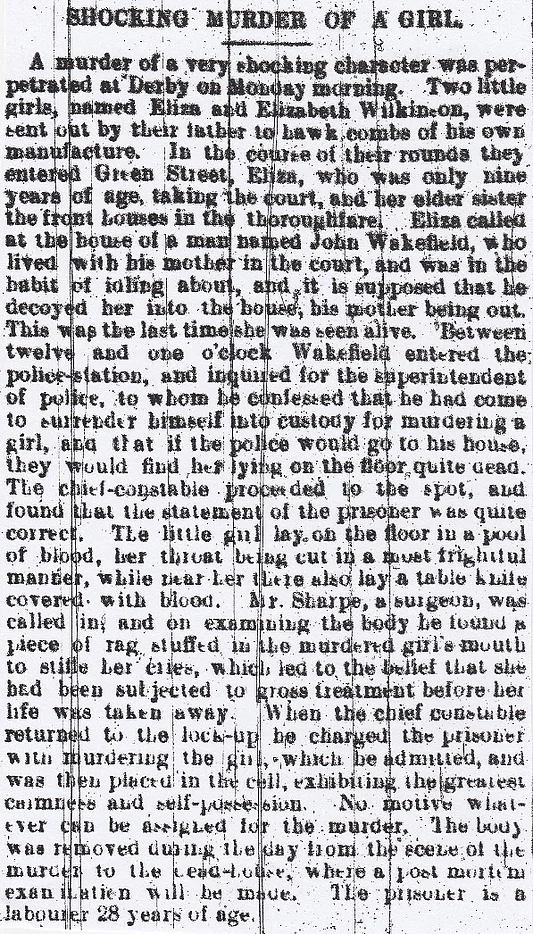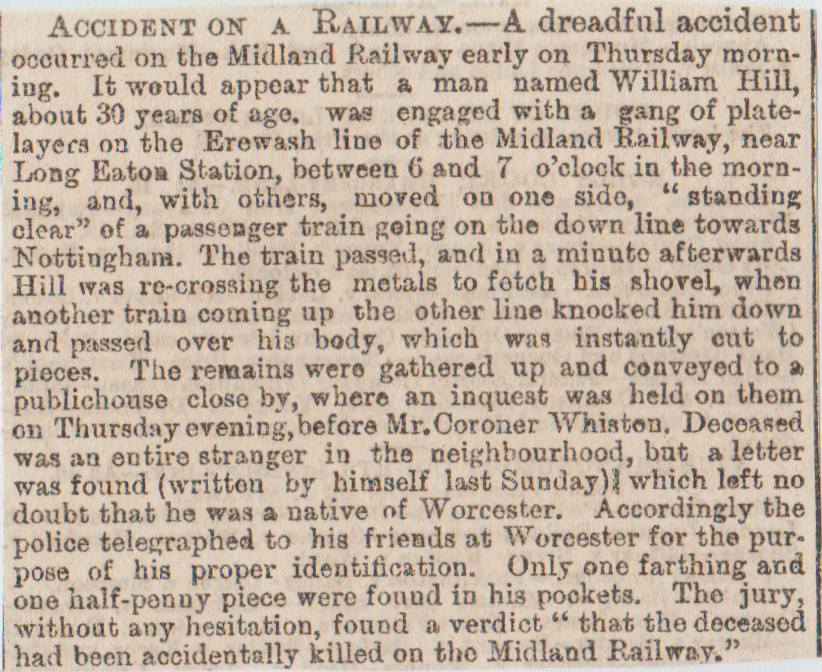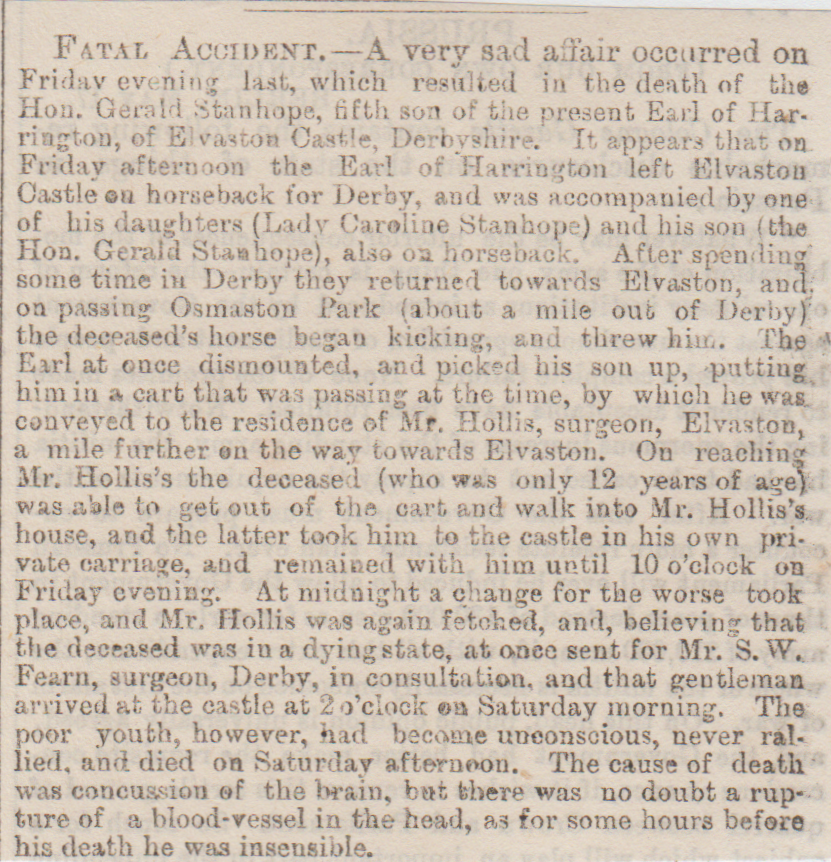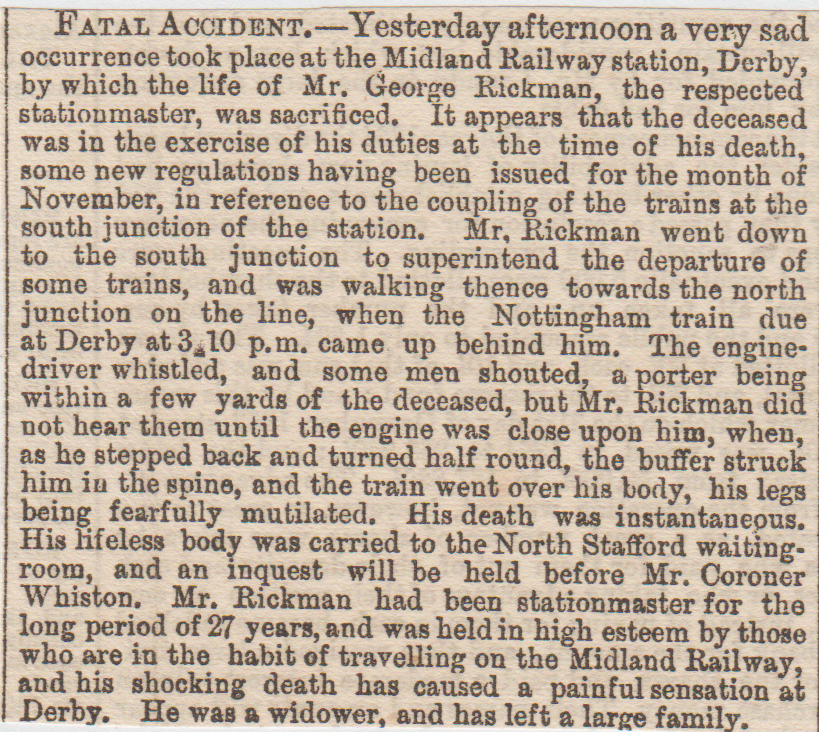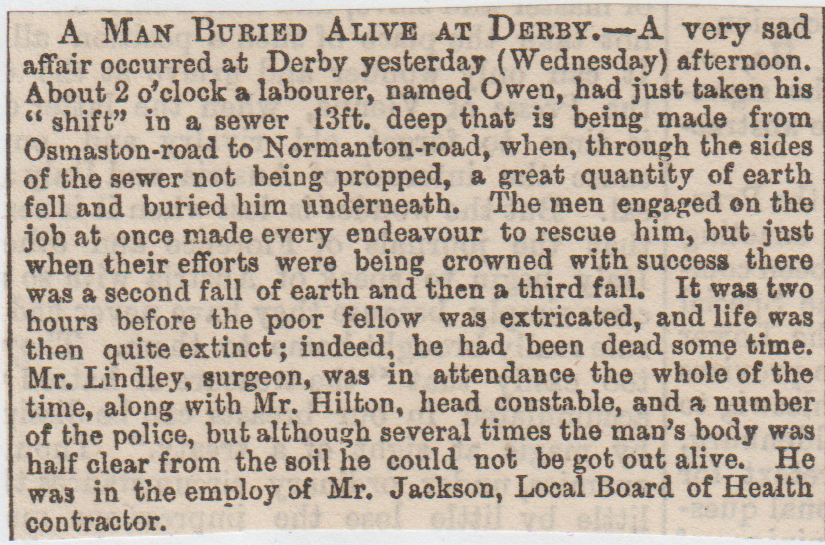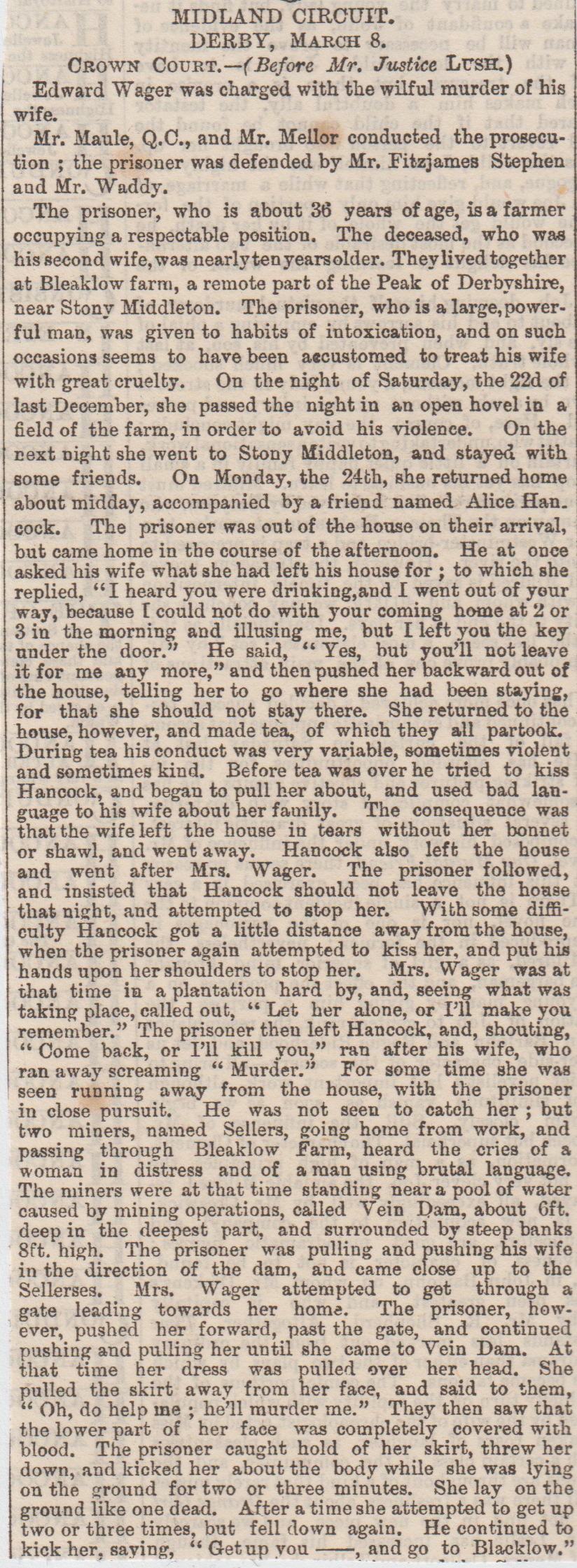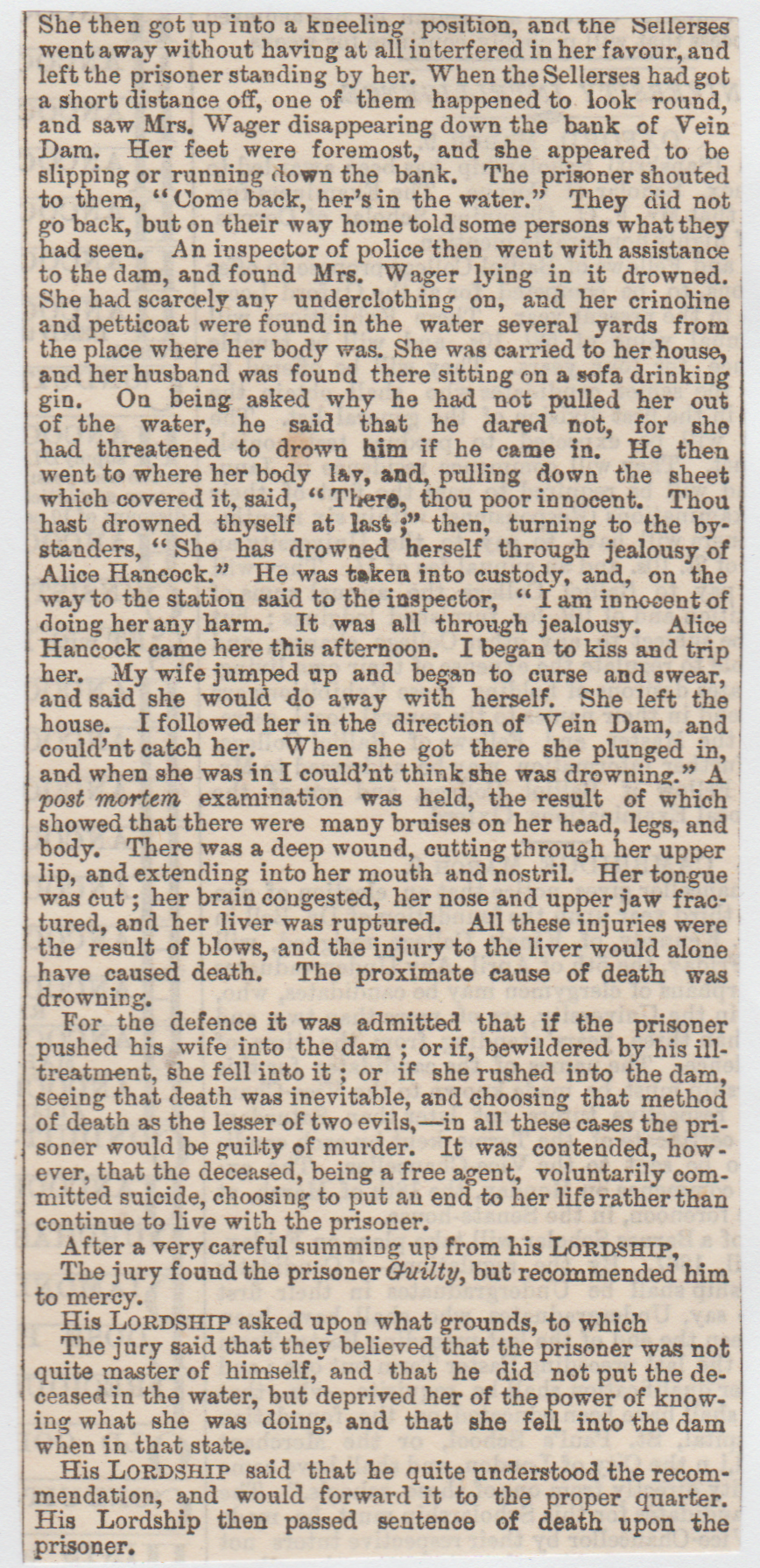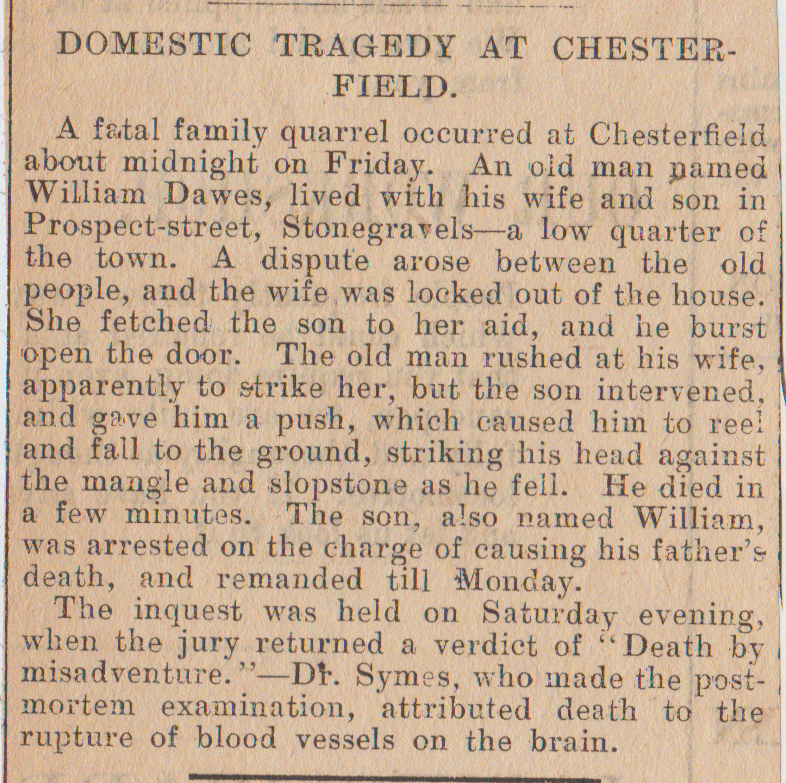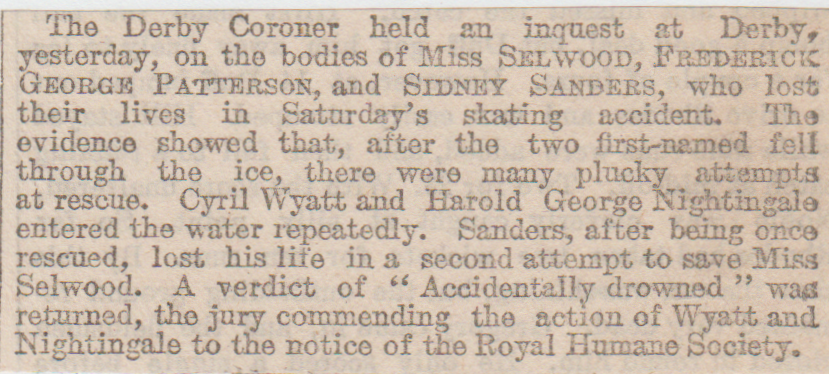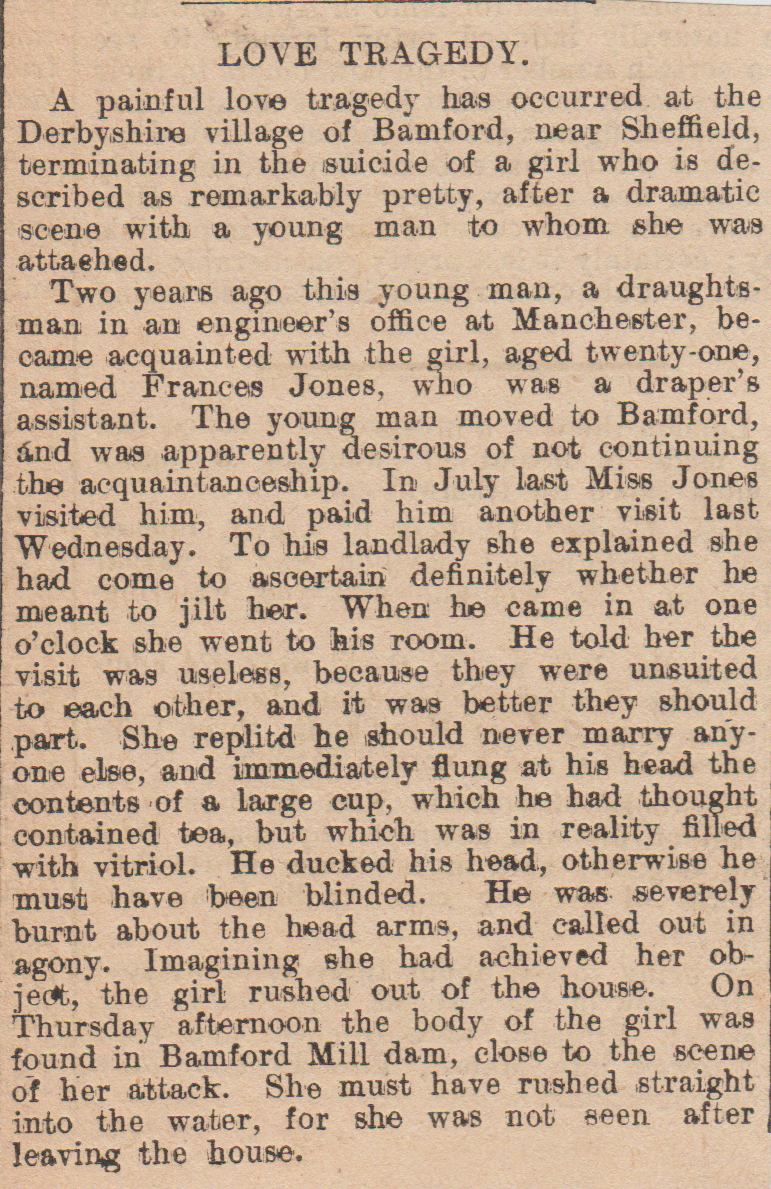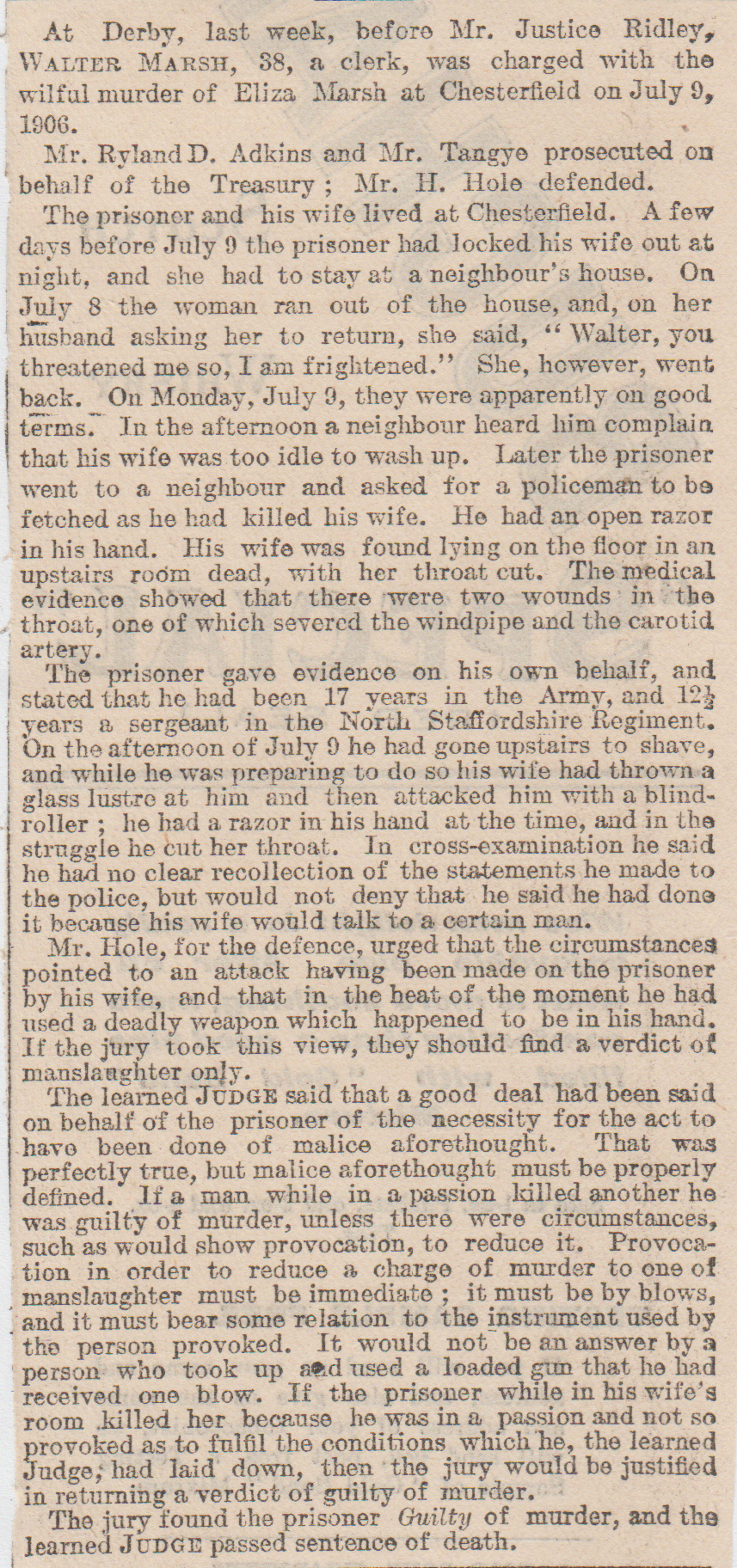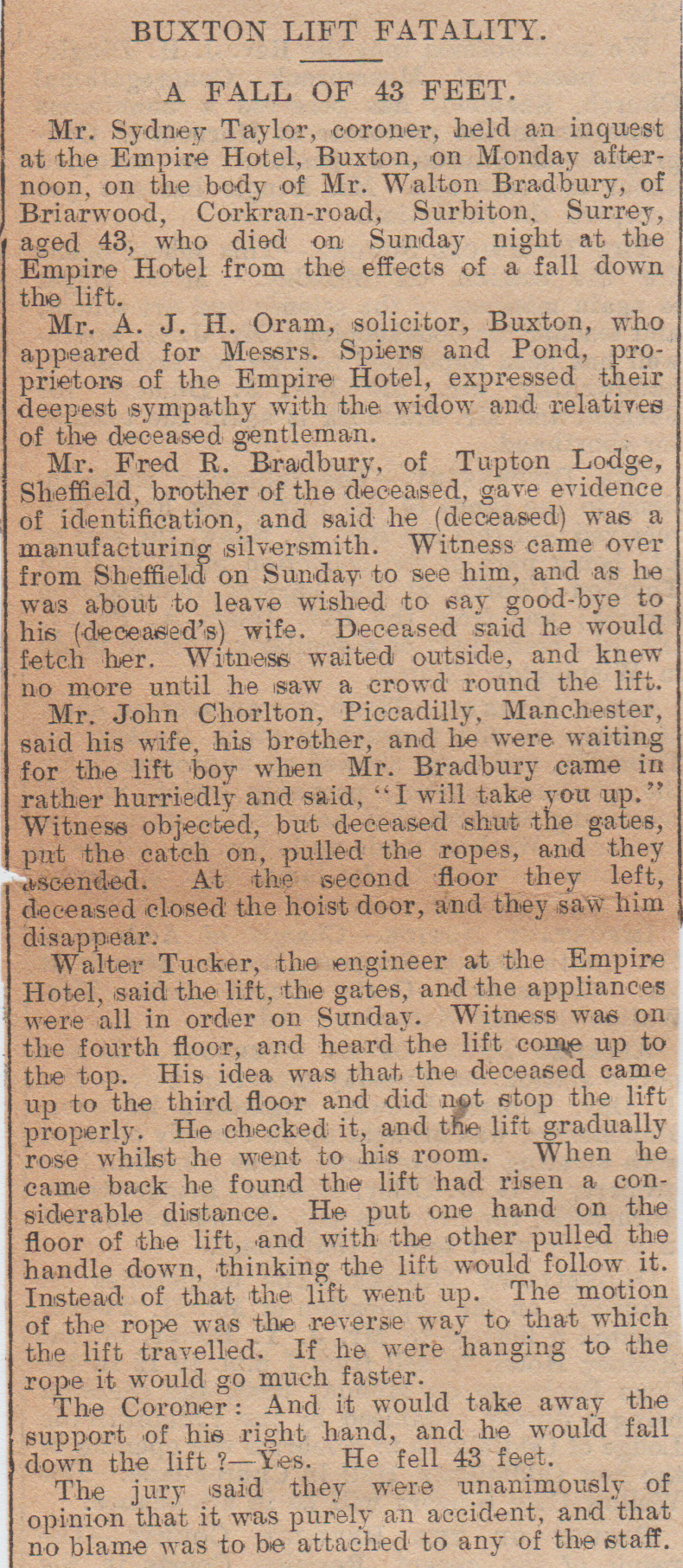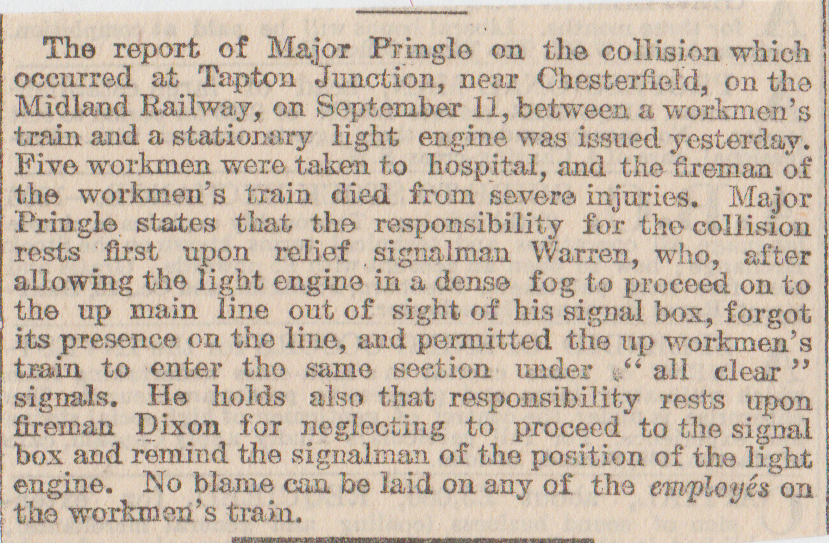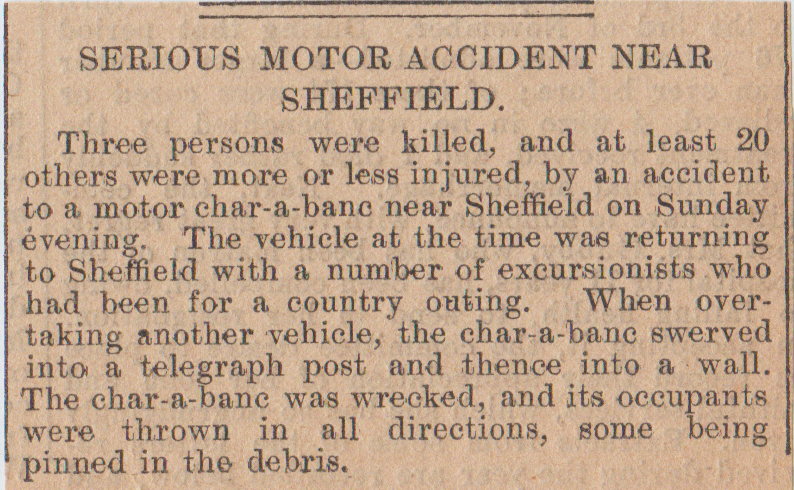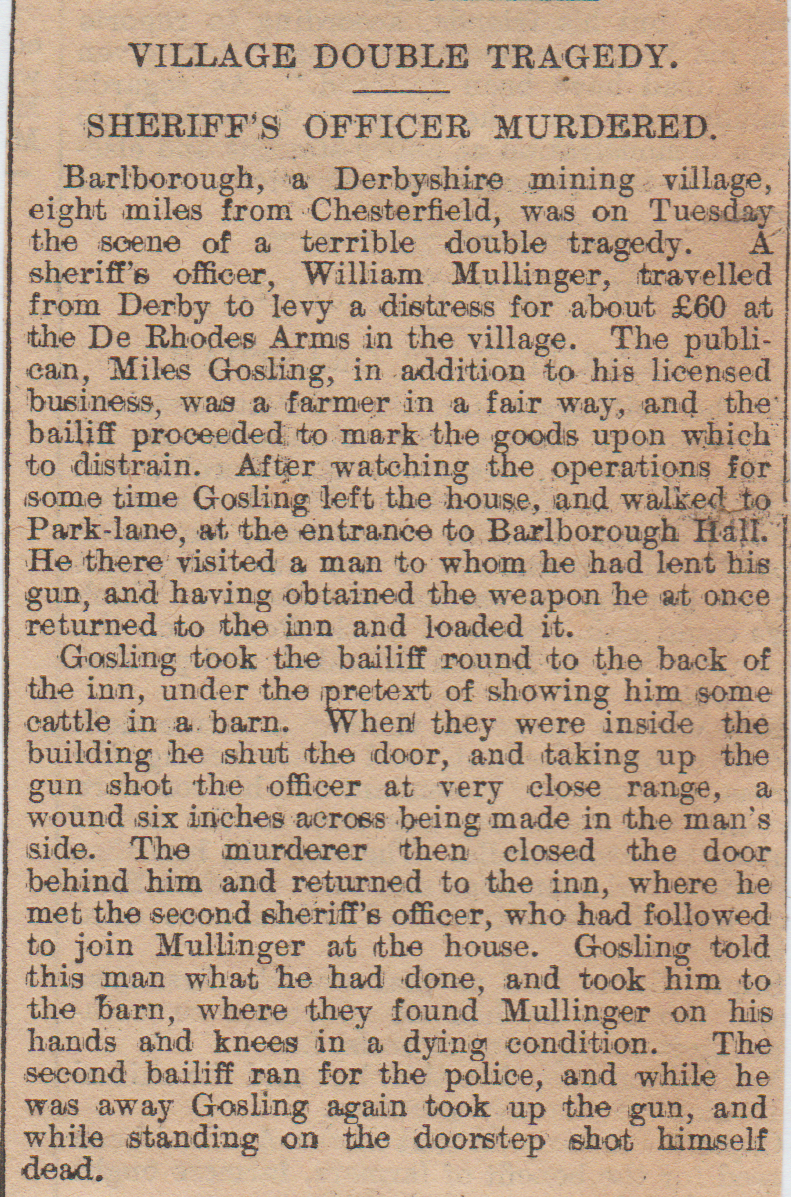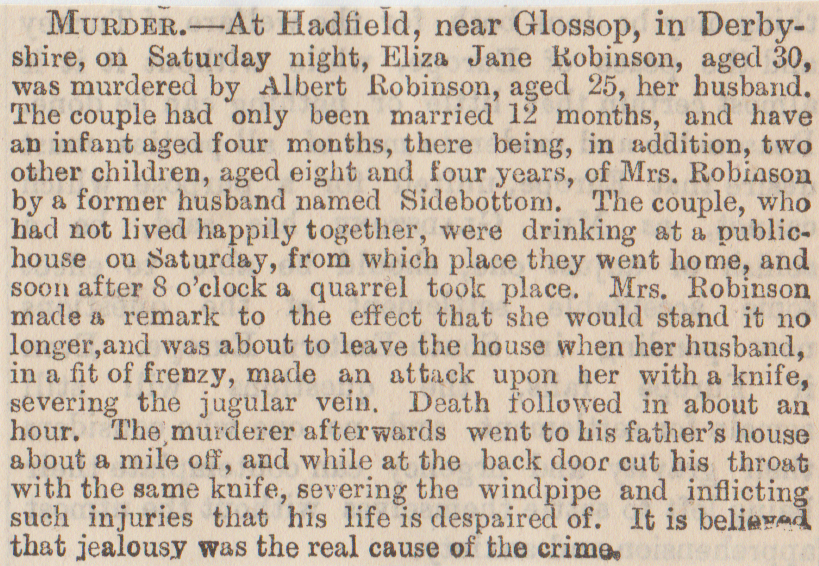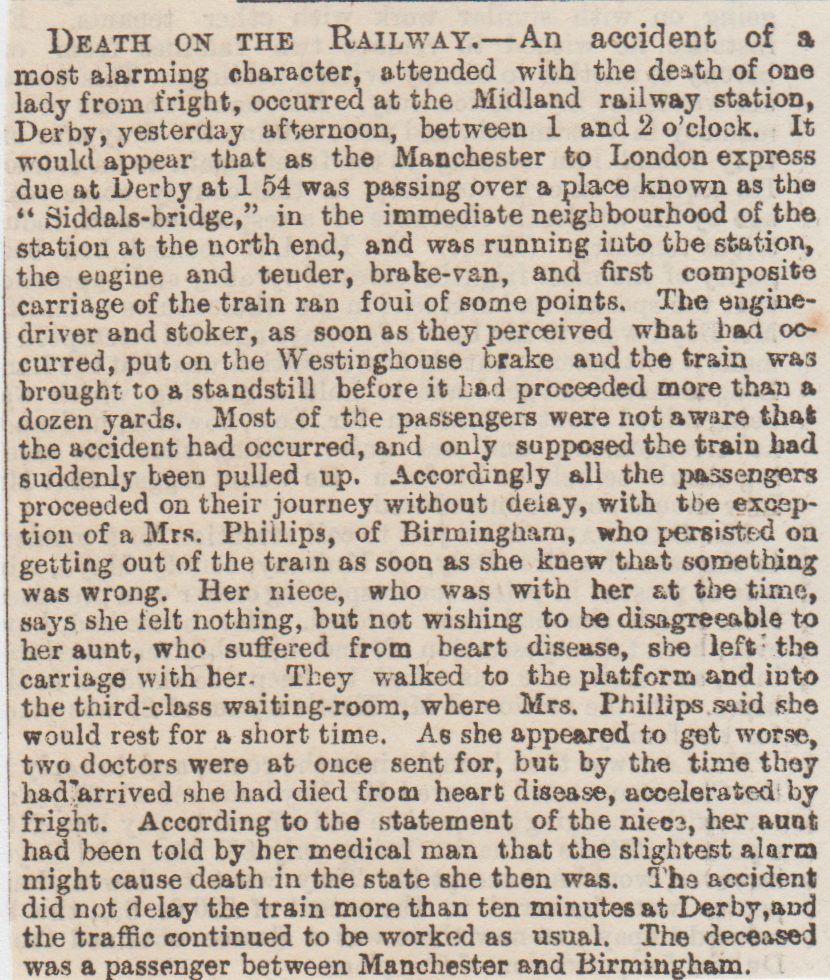1/ Allestree Church Suicide, near Derby, October 1898
Village postmaster’s wife, Mary Watson, was the church cleaner. In a fit of despondency, she threw herself down a well which is used for the clock weight’s to go into. The well is twenty feet deep and under the church tower and she was found head first in some slurry at the bottom of it.
2/ Ashwood Dale Murder, near Buxton, July 1894
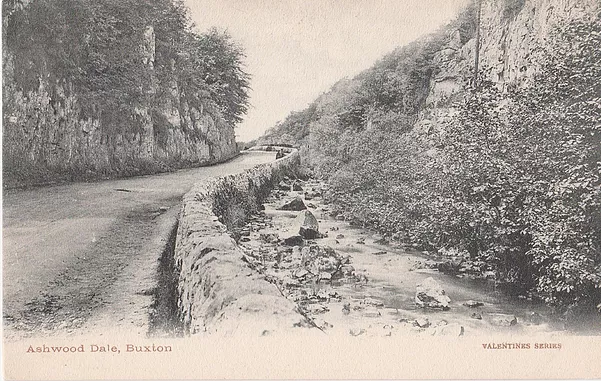
The dead body of a sixty-year-old woman was found on a side road from the above picture. She was lying on her back, with a severe wound on the back of her head, meaning she probably had her back turned to the attacker. The body was on the Ashwood Dale to Staden road, which is not used that often. (Who was she?)
3/ High Tor Fatality, Matlock, November 1886
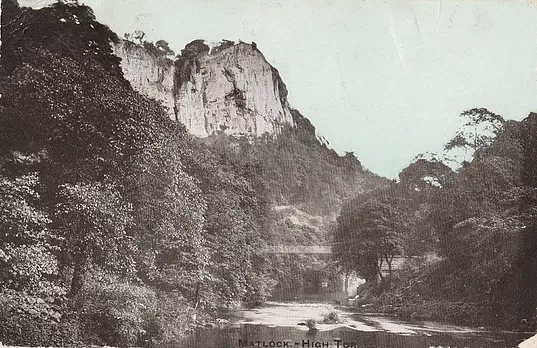
A single lady named Lock from Dorchester was staying at the Hydropathic Establishment at Matlock Bath and was killed by falling off the above cliff, High Tor Rock, which is about two hundred feet high.
4/ Little Eaton, (Two Boys Drowned), January 1884
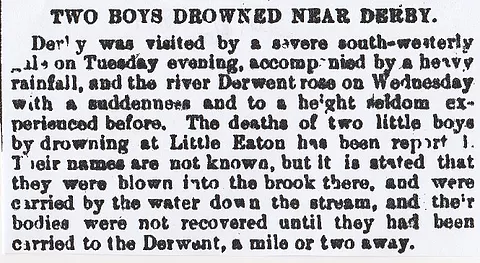
5/ Hadfield Murder, near Glossop, October 1880
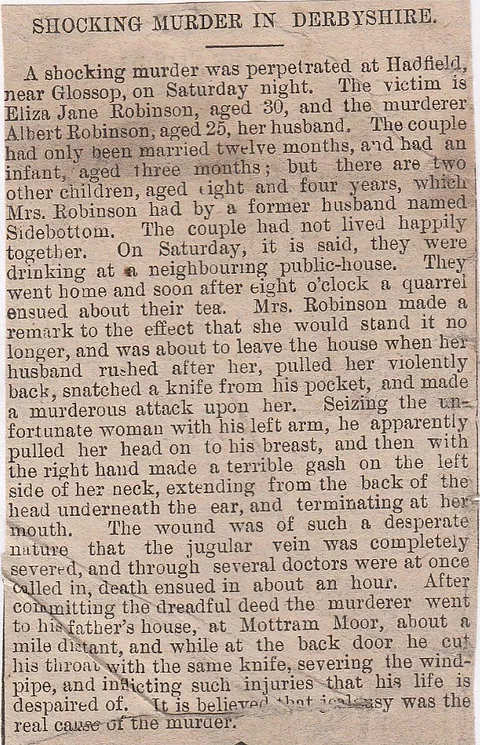
6/ Derby, June 1885 (Swallowed a Pin)
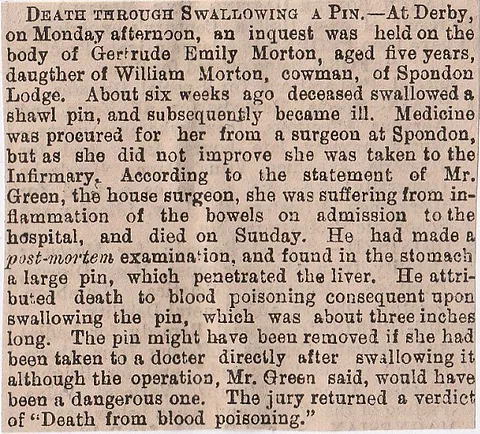
7/ Bradwell Murder?, June 1885 (Was She Murdered?)
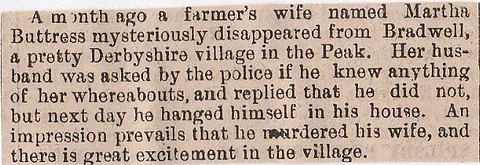
8/ Chesterfield Station, (Child Fatality) June 1868
A coal miner’s daughter named Heenan was killed at Chesterfield Station, in a tragic accident. The six-year-old girl was collecting coal where an engine was shunting some waggons on to a siding. Being only slight in stature, she went unseen by the driver and she was run over by a waggon which nearly cut her head off, but cut her hands off instead. Her body was taken to her home in Waller’s Yard, St Mary’s Gate.
9/ Addington Dale, April 1900 (Two Brothers Killed)
George Bills and John Bills, eighteen and twenty respectively, both butchers assistants in Buxton, left there at 7-40 a.m. on a tandem and headed for Flintham, a village between Nottingham and Newark, for an Easter visit home. Just under an hour later they were in a gravel pit, both dead. The pit at Addington Dale was where they were found and the cause was going over the edge while going too fast. The tandem was brakeless, which explains the speed they were going, especially in Derbyshire where the hills are notoriously steep. Both were removed to Taddington for an inquest.
10/ Glossop Wife Manslaughter, February 1885
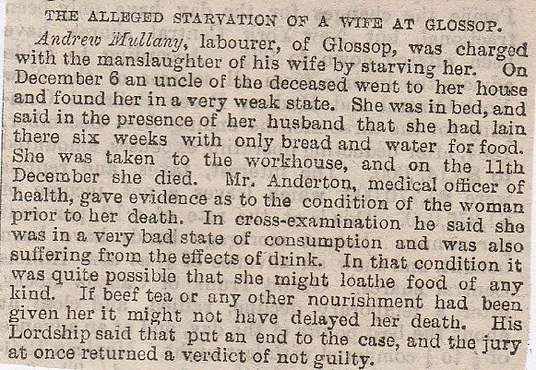
11/ Stanton Ironworks Death, March 1854
Henry Smith was a bricklayer who working on top of a furnace at Stanton Ironworks, and this furnace was being blown out so that repairs could be undertaken on a wall which had collapsed. He was on the gas conductor waiting to remove it when it gave way and Smith was dropped into a cauldron of molten liquid. Fellow workers ran to his aid and doused him in cold water. Then two hours later they dragged the furnace but only charred remains were forthcoming. The trunk of his body was the only thing visible on the corpse, arms and legs virtually disappeared. He was a strapping six-footer and fifty-years-old and all colleagues liked the man. He also leaves a missus and eight kids with no father.
12/ Dinting near Glossop, June 1899 (Railway Death)
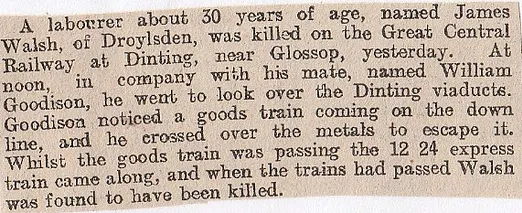
13/ West Hallam Station Fatalities, October 1884
At West Hallam Station on the Great Northern Railway, a man named Bostock and his wife were killed by a train. They were scurrying across the lines in order to catch the train for home.
14/ Eckington Murder/Suicide, August 1890

15/ Eckington Murder/Suicide, August 1890
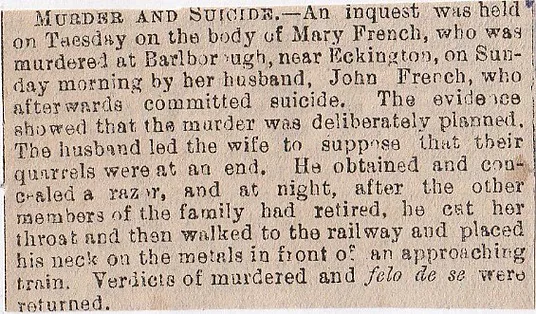
16/ Ashover near Chesterfield, February 1879 (Accidental Hanging)
Farmer, David Townrow from Ashover near Chesterfield, committed suicide under a weird set of circumstances. He was obsessed with the Banner Cross murderer, Charles Peace (killed a copper in Manchester then fled to Sheffield and became obsessed with a neighbour’s wife and then shot husband dead. Hanged on the 25th February 1879, a couple of weeks after this fella.) He couldn’t read so paid people to read the stories of Peace to him. Townrow also had a thing for hanging. He’d shown signs of derangement recently and was watched, but he evaded them he went up to a hayloft and hung himself. (To emulate his hero?)
17/ Wellington Street, Matlock Bank, (Fatal Accident) June 1899
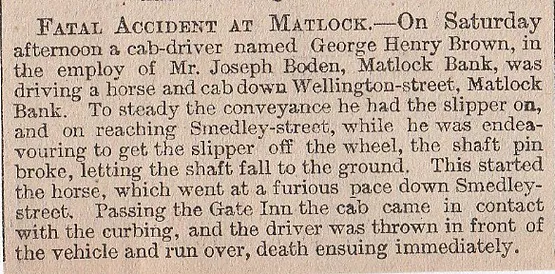
18/ Derby Teacher Suicide, December 1858
Elizabeth Butler was a fifteen-year-old pupil teacher at Trinity Schools, Derby. She committed suicide by drowning herself in the River Derwent and she left a little note in her book saying Goodbye and stating that this was premeditated, as she had had an argument with Miss—, and that the woman had got it in for her. She asked her friends to forgive her, and also hoped God would also forgive her.
19/ Osmaston near Derby, March 1897 (Incest)
At Osmaston near Derby, the body of an unnamed child of which the mother was a sixteen-year-old, named Eliza Taylor. It turned out that the father of the child was the girl’s own father!
20/ Opposite Duffield Church near Derby, May 1871 (Suicide on Railway)
As the train arrived opposite Duffield Church, a smart young lady was seen to gently place herself on the track on which the train was approaching. The train went over her body cutting it in two, and later inquiries produced the name of Kate Green from Brighton. Kate had been staying with a relative in Litchurch Street, Derby, and was of weak intellect. She left the house on Sunday night to go to St Andrew’s Church but never got there.
21/ Derby Murder, April 1880
22/ Repton Mill Murder, February 1899
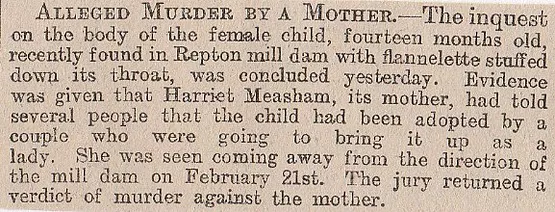
23/ Repton Child Murder, April 4th, 1899

24/ Tuebrook, West Derby, June 1865 (Fatal accident)
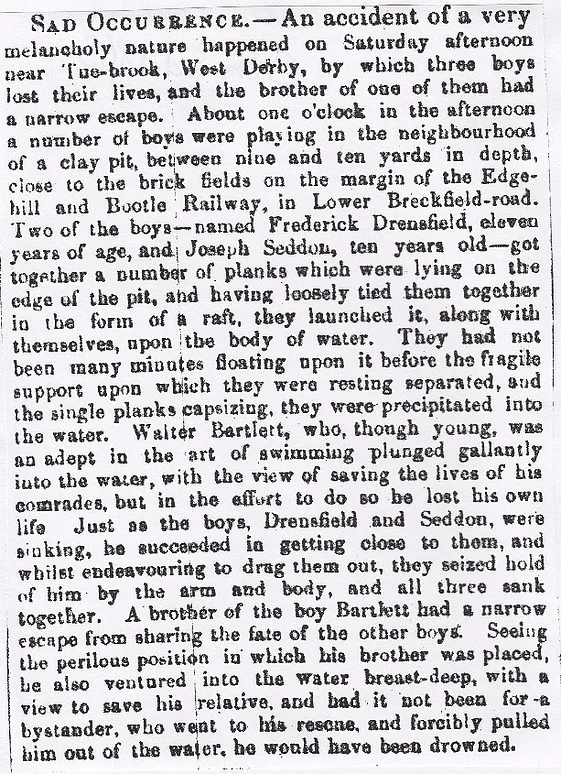
25/ Shuttlewood, (between Chesterfield & Mansfield) February 1909 (Gas Explosion)
Four people died in a terrible gas explosion in the colliery hamlet of Shuttlewood. The occupants of the house were asleep in bed when neighbours were woken by a massive report, which shattered windows and destroyed part of the roof. John Wheldon, formerly a collier at Oxcroft Pit and his son John along with the baby, only a year old, were found dead in one room and the mother, who was shockingly injured, has died at the hospital. Two other children were buried in debris, but are expected to recover and a collier and his son also escaped injury. It is believed to be a gas explosion, but it is not definite.
26/ Whaley Bridge Accident, February 19th, 1885

Whaley Bridge February 25th, 1885
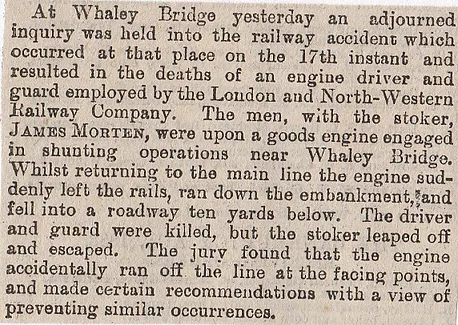
27/ Matlock Bath, (Skeleton Discovered) October 1891
A discovery at Matlock Bath is expected to solve the mysterious death of a visitor. Workmen repairing the roof at Stevens paintworks, situated under High Tor, found a skeleton of a man on a ledge in the rock. The bones were those of a male, who had wandered along the face of High Tor, a five-hundred-foot high rock near the Derwent when he must have fallen and broken his legs. His hat and coat were nearby and death was immediate. A visitor went missing fourteen months ago and was never found. A companion of his said to police he left him near some rocks and saw him robbed of a watch and pushed over a cliff. A search was made at the time, but the rock face was not explored. (Who was he?)
28/ Bolsover Colliery Fatalities, August 1892
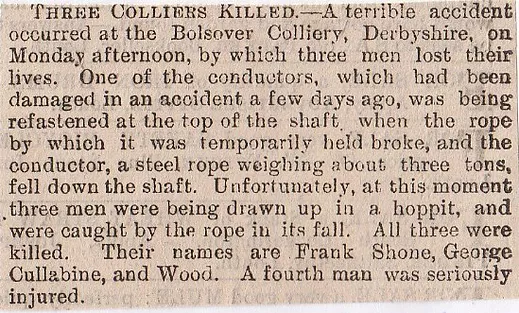
29/ Death in Buxton Church, August 1889
Just before service commenced at Buxton Church on Sunday morning, a visitor from Birmingham, named Tamlin aged sixty, was seized with a fit and died immediately after being carried into the porch of the building.
30/ Derby Railway, (Unknown Corpse) August 1889
On the arrival of a return excursion train from Liverpool to Birmingham at Derby on Tuesday, the body of a thirty-year-old man was found in a third class compartment. There were no marks of violence and the man had apparently been dead only a short time. In one of the pockets was the address of a Birmingham hostelry, but on enquiry, by telegraph, it was ascertained that he was unknown there. The body has not yet been identified.
31/ Bradwell Suicide, June 1st, 1885
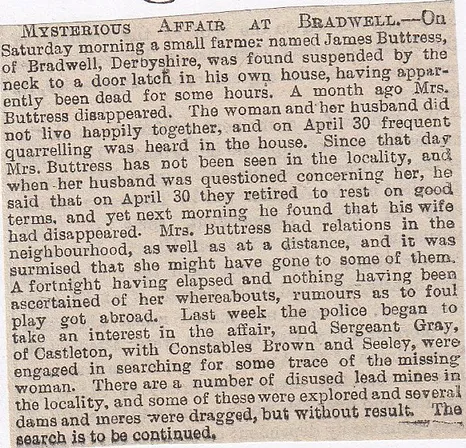
Bradwell June 2nd, 1885
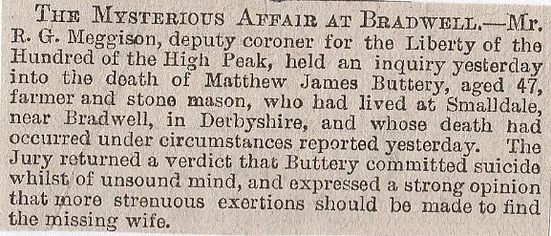
32/ Old Nottingham Road Murder, Belper, September 1879
The dead body of Sarah Ann Harrison, wife of Thomas Harrison a horsenail maker, was found in a field next to a wall. It had been there a few days and was soaking wet from the showers the night before. Thomas had to go to work every day and literally walked past his wife’s corpse on those days, he was a couple of yards from her, only a hedge hid the body. The husband really didn’t seem too bothered and never told police an information about her disappearance. Sarah had two daughter’s, one aged sixteen and another aged fourteen, but the two had left home a couple of months since and now live in town. The girls and Sarah’s sister knew nothing. Apparently, she had a miserable life with Thomas and regular beatings were not unheard of, but she was a decent woman and no reason for the murder of her can be attributed to anyone. Also, the husband was the one to find her body first. (Coincidence? Was it Him?)
33/ Chatsworth House Death, September 1885
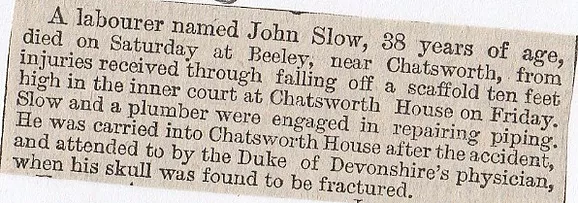
34/ Aston-on-Trent, February 1897 (Human Remains Mystery)
Seven miles from Derby, three blokes were walking next to the River Trent when they spotted a human trunk lying on the bank. They went and got the village policeman named Haddock, and he examined the human remains. The head, legs and left arm were missing, and the right arm was only partially attached. There is an embankment nearby and it is believed it had washed down from a higher part during the recent floods and had got stuck on the bank. The remains were badly decomposed and had obviously been there for ages.
35/ Folly House Suicide, Darley Field, August 1896

36/ Rivett Street, Derby, December 1900 (Pub Fatality)
Alfred Pegg, the landlord of the Sir Henry Wilmot public house in Rivett Street, Derby, died in the local infirmary on Friday morning from falling into a mash-tub full of boiling water from a piece of board on which he was standing.
37/ River Derwent Drowning, September 1906
While a number of Milford boys were at play one afternoon in a field belonging to Mr Knifton at Swainsley, one of them, Albert Dawson aged five and a half, fell into the River Derwent and was drowned. The lads were swinging on the branches of overhanging trees and Dawson dropped off into deep water.
38/ Matlock Suicide, August 1885
The body of James McFarlane Dickson, a retired gentleman of about forty-years-old, the former superintendent of Covent Garden Market, committed suicide in the bedroom of a house where he was visiting, having shot himself in the mouth with a revolver. He lived in Brixton and used to suffer from religious mania and was here to help with his health problems.
39/ Glossop Drowning Case, August 1885

40/ Woodhead Suicide, March 1885
Some men who were walking by the side of a brook at Woodhead discovered, partly immersed in the water, the dead body of a man named John Green Howard, who had been missing for a week. His legs were tied together and his throat was cut. It is supposed that he committed suicide.
41/ Miller’s Dale near Tideswell July 1885 (Drowned)
An inquest was held at Tideswell touching the death of a young man named William Chapman whose body was taken out of the River Wye at Miller’s Dale. Deceased and some other young men went to bathe in the river at Miller’s Dale. He got out of his depth and although every effort was made by his companions to rescue him, he was carried away in and drowned.
42/ Balmoral House Mystery, Matlock, December 1872
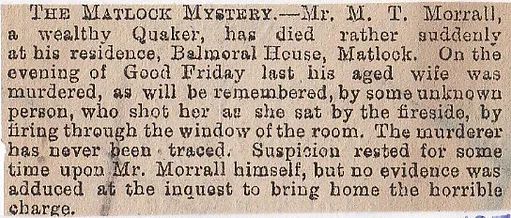
43/ Chesterfield Suicide, December 1861
Mrs Anne Turner, an affluent lady aged fifty, committed suicide at Chesterfield. She had been seeing Charles Harrison, and his begging of late had been a source of annoyance so great that she was afraid to go home. She sent a message one morning to a guy named Middleton, via a boy named Charles Lowe, to say she wanted to see him. When he returned the boy found the door closed so he heaved it open and saw her hanging from a rope, which was fastened to the ceiling and she was facing the wall. He ran for help and neighbours cut her down but she was dead. Turner had put on her best clothes and written a letter saying how her money was too divided. She killed herself because she was scared of Harrison and fed up of him stalking her.
44/ Brewery Street, Chesterfield, September 1885 (Traction Engine Fatality)
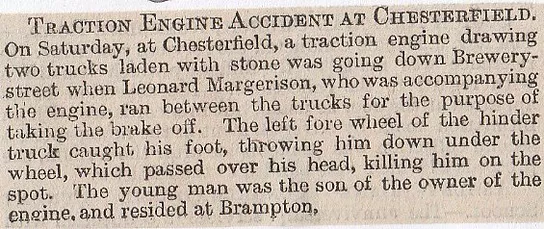
45/ Derby Railway Station Death, October 1850
At 10-30 p.m. at the railway station at Derby, a scruffy man had been hanging about the station yard and staff became suspicious. At the above time the mail train trundled in and the stoker of the train told a policeman that he thought he’d hit something just moments earlier. Police searched the area and found the scruffy man, mangled to bits on the track. All of the carriages ran over him and near his body were three packages, which this thief had stolen from the luggage carriage on the London train. Deceased was unknown.
46/ New Mills Drowning, May 1885

47/ Matlock, April 1893 (Skeletons Mystery)
During excavations at Matlock were under way, workmen found four human skeletons. Post-mortem examinations prove they are all middle-aged men and were all violently battered to death, proving murder. It was also estimated that they had been buried for about forty years. Near the corpses were found a defaced coin and a pen-knife. (Who were they? Where are they buried?)
48/ Dethick Farm near Matlock, December 1900 (Sleepwalking Death)
Police discovered the body of a single young man named Newton, at Dethick Farm near Matlock. His body was in an outbuilding and he lay there while his brother was asleep upstairs. The brother says he was unaware of his brother’s death, but one theory is that while sleepwalking he fell and broke his neck.
49/ Melbourne Wife Murder, April 1885
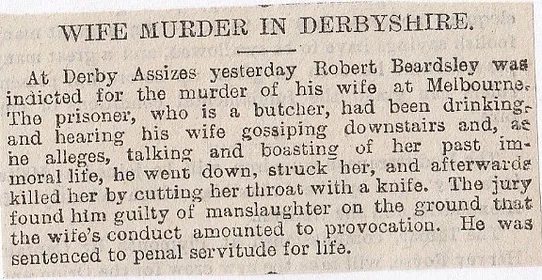
50/ White Hart Pub Suicide, Derby November 1869
Emmanuel and Louisa Victoria Cheeseborough, his thirty-year-old wife ran the White Hart pub in Bridgegate, Derby, for quite some time, but one night were arguing with each other till the early hours. Police were called and they both calmed down and went to bed. Before going to bed, the wife went to her 12-year-old son’s room and said these creepy last words,
“You shall have all I have; I’ll leave to you, for I am going to die”……………………………………..Err! Yeah. Goodnight Mum!
Then she went to the clubroom, drank a liquid with poison in it and went to sleep, where she was found at 2-30 a.m. The coroner said it was the poison that killed her probably vermin killer.
51/ Derby Rifle Range -I think it was 1883? (Forgot to date it)

52/ Bolsover, December 1910 (Three Children Killed)
It was at the level crossing in Bolsover that three children were killed and one injured while trying to cross it. The children had left the cinema show and were on their way home when they tried to cross, a passenger train ran into them. They were kind of in the cross-fire because the Chesterfield train was rushing up one way and the coal train from Lincoln in the other. Some dodged both but three failed in their attempt. The accident was in full view of hundreds of witnesses. One little boy was so badly crushed that only identification will be known when parents call in to say he hasn’t turned up from the show. The other two deaths are a son a daughter of a Carrvale miner named Bacon, both six feet away from the other. The injured boy, who may not come through, was named Yates and from Bolsover. He had an operation on his fractured skull, but it’s not looking good.
Those killed were; George Alfred Boot aged eight, of Hillstown; Mary Margaret Bacon aged nine, of New Bolsover, and Joseph William Bacon, brother of Mary, aged ten. Arthur Yates aged nine, with a fractured skull.
53/ Murder at No.99 Stanhope Street, Derby, July 1906
Three Derbyshire Constabulary policemen heard the shouts of Murder! and Fire!, at midnight. They entered the home of Robert Porteous at 99 Stanhope Street. The husband was badly burned but Mrs Porteous was on fire and they managed to douse the flames and get her out. A paraffin lamp was smashed on the floor and was thrown into the heat of an argument. Mrs Porteous was on her death-bed and her last words were heard by police and the husband. She died shortly after, but as to who threw the lamp, or what her last words were, we’ll never know.
54/ River Derwent, Derby November 1885
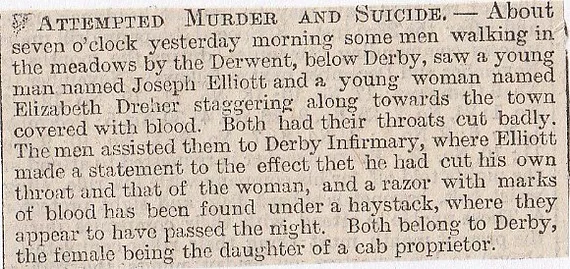
55/ Brimington Suicide, September 1886
Eliza Ann Brunt aged seventeen was found dead in the canal at Brimington near Chesterfield. The father treated her with immense cruelty and when he arrived at the inquiry into his daughter’s death, there was a huge groan by the crowd. If the police hadn’t been there he’d have been torn limb from limb. The neighbours and the grandmother gave evidence, saying that Eliza was regularly seen with bruises and a black eye. The day before her death she told her grandmother that her father said he would kill her, and that this would be the last time she’d share a cup of tea with her. The jury expressed their disgust at the father’s treatment, but gave the verdict “Suicide whilst of unsound mind”.
56/ Derby Wife Murder/Suicide, September 1885
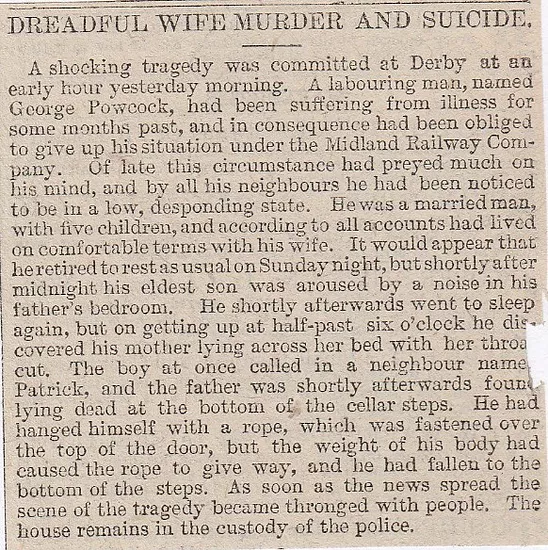
57/ Derby, July 1867 (Derwent Suicide)
Maria Smith aged sixteen, of Duke Street, was seeing a young lad from Derby and one day they had a slight tiff. She took it to heart and became very low and despondent. On Sunday evening she asked a friend to go for a walk by the Derwent with her. They went by Darley Grove and came upon the fields near the river and stayed till 9 or 10 o’clock when a few lads noticed her acting strangely. They then spotted her taking off her hat and cape and rolling her sleeves up as if to jump in the river. One of them heard her say “she did not want to go home that night”. The boys urged her to go home and not do anything stupid, but she simply replied: “if she did go home, they would have to carry her.” The lads made a grab for her but she slipped free and dived into the river, then watched her sink down. Police dragged the river and recovered her lifeless body.
58/ Clay Cross Iron Works near Chesterfield, December 1856
A man named Kelly, a labourer at the Iron Works was employed to put stuff in the furnace. A large burning mass fell upon him, burying him up to the middle and it was fully half an hour before they got the poor chap out. The debris had clinkered around him and had to be chiselled away. The pain must have been incredible, and at one point he told them to drown him in the reservoir to relieve him from his misery. The right leg had to be amputated and the other is so bad, that it is feared that it will have to be cut off as well. (Did he survive?)
59/ Trent Station Tragedy, April 1889

60/ River Derwent Drowning, Derby, June 1885

61/ Chesterfield Suicide, May 1867
George Gilberthorpe was a sixty-seven-year-old, ex-porter on the Midland Railway, who had been married for a second time to a wife who was much younger than himself. She ruled the roost and often told him she wished he was dead and then she could get his funeral money from the club. One day she turned him out of the house, so he wandered about the streets of Chesterfield for a while and then asked for admission to the workhouse. This was denied. In the meantime, the wife had sold all the furniture and contents of the house and fled with the money, so when he returned home there was an empty shell. One day later a man was passing and saw a hand between the glass and blind, and when police entered they found him hanging by a piece of cord. Inside his pocket was the suicide note, and it read:
“Chesterfield May 1st, 1867- I Joseph Gilberthorpe, do hereby wish that my son, Henry, receive my funeral money from my lodge, and he shall pay what few shillings I owe to James Wilkinson. And he shall have my clothes box, and all other things belonging to me, and from the ingratitude and abuse I have received from my son William, and his wife, and all the rest of his children; and the pride and contempt of my wife and her two sons, their scoffs and frowns, and to be ordered away from the house to seek lodgings elsewhere is more than I can bear, and has driven me to the rash act I have done. May the Lord have mercy on my soul and forgive me in this world, and in the world to come is my sincere prayer. God have mercy upon me. Amen and Amen.”
Nobody ever saw his wife again, and he was declared temporarily insane, by the jury.
62/ Buxton Drownings, January 1887
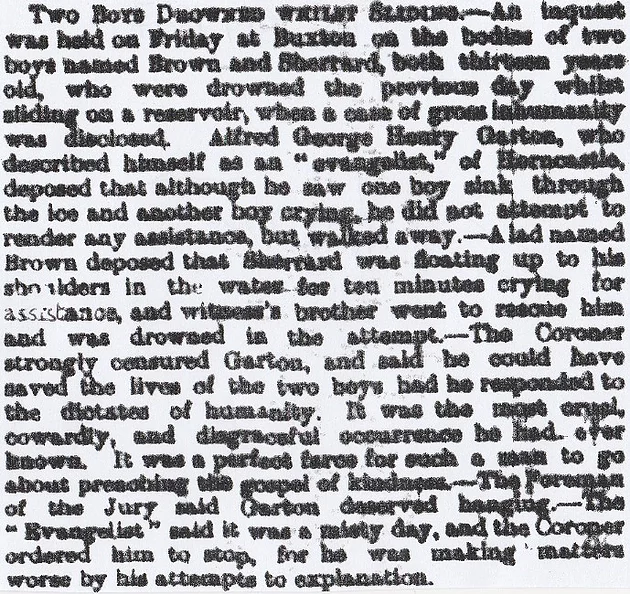
63/ Derby, Attempted Murder/Suicide, September 1884
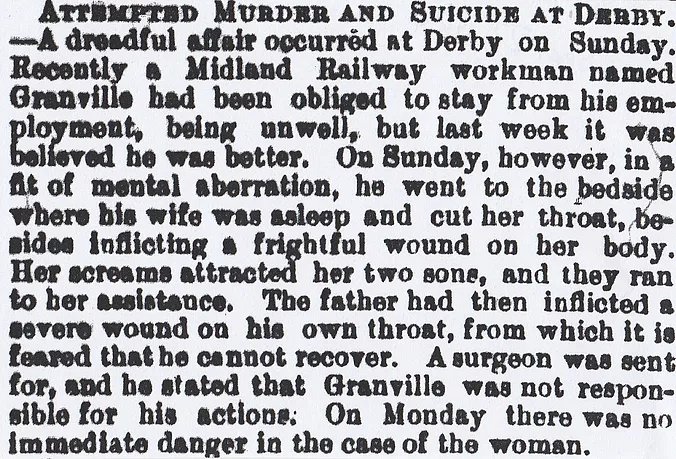
64/ Queen Street, Derby – (Fatal Fire) September 1870
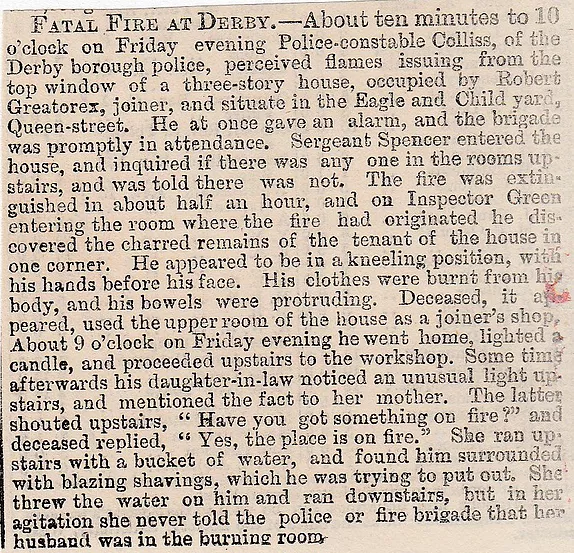
65/ Fatal Accident at Long Eaton Station, December 1870
66/ Horse-riding Fatality, Osmaston Park, Derby. May 1866
67/ Derby Railway Station Fatality, November 1866.
68/ Man Buried Alive in Derby, October 1866 (Osmaston Rd/ Normanton Rd)
69/ Fatal Fire near Matlock, October 1866 (Hackett Tape Mills)
70/ Murder in Belper, December 1866. (The murder took place at Chapel Hollow. St John’s Road was better known as Chapel Hollow in the 19th century)
71/ Wife Murder near Stony Middleton, March 1867
72/ Fatal Family Argument in Chesterfield, June 1903. (Prospect Place, Stonegravels)
73/ Temple Normanton Murder, December 1903. (Murder of Frances Rawton, servant girl)
19th December 1903.
A reprieve has been received in the case of Samuel Redfern, twenty-five, waggoner, who was given the death sentence for the murder of Frances Rawson, the sixteen-year-old domestic servant, employed at the same farm at Temple Normanton. The jury recommended him to mercy on account of his weak intellect. The Home Secretary commuted the death sentence to one of penal servitude for life.
74/ Father Murders His Two Children, Mosborough, May 1904.
75/ Fatal Colliery Accident- Swanwick Colliery, March 1904.
An accident which occurred at Swanwick Colliery in Derbyshire, yesterday morning, in which three miners were killed- Samuel Haycock, John Cope and William Topham. In the company of others, they were descending the pit when the cage suddenly stopped-it is believed through some defect. The men were jerked out and fell a distance of over seventy yards (over 200 feet) The others managed to hold on and were rescued an hour later. The men who lost their lives were all married. Cope had no children, but Haycock leaves eight and Topham left thirteen.
76/ Three Killed in Skating Accident at Osmaston, January 1904.
Rose Selwood, aged twenty-one, and her young man George Patterson, aged twenty-nine, and Sidney Sanders were drowned skating on Osmaston dead waters at Derby.
77/ Suicide in the Cromford & Langley Canal, September 1905.
78/ John Silk, Chesterfield Murderer (Execution Date) December 1905.
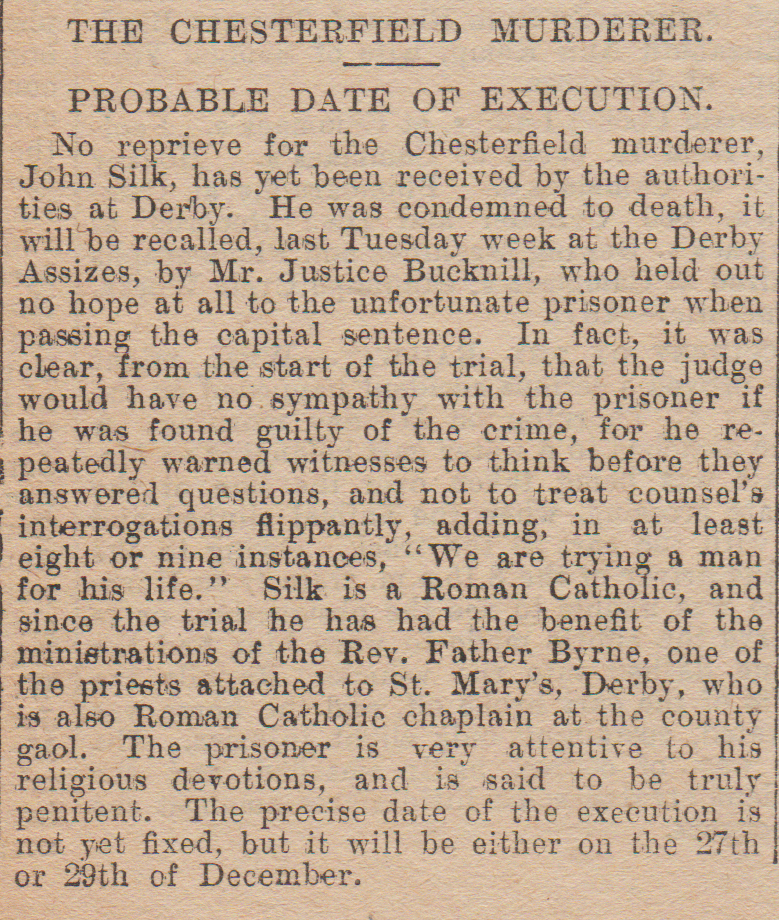
79/ Suicide of a Girl at Bamford Mill Dam, August 1905.
80/ Chesterfield Wife Murder. December 10th, 1906
Friday, December 28th, 1906 (Execution of Walter Marsh)
Walter Marsh, aged thirty-nine, an ex-sergeant in the North Staffordshire Regiment, was hanged at Derby Gaol yesterday morning for the wilful murder of his wife, at Chesterfield, on July 9th. Pierrepoint, of Bradford, was the executioner, and Ellis, of Rochdale, assisted him. The prisoner, who acknowledged the justice if his sentence, died penitent. (His wife was about seventeen years his junior. Due to the weather in Derby in December, a pathway was cleared in the snow for the procession to the scaffold.)
81/ Lift Tragedy at Empire Hotel, Buxton. September 1906 (Off Park Road. Was opened in 1903, then demolished in 1964)
82/ Glossop Murderer Reprieved, March 31st, 1906. (George Alfort Smith murdered his auntie)
83/ Signalman Blamed for Deaths at Tapton Junction, near Chesterfield. December 1906
84/ Three Killed at Moscar. August 1907. (The three victims were:- Benjamin Handley and Hugh Fearn, who were both married men, and five-year-old William Harrison. Dore Moor Inn, the car was examined and chauffeur said it wouldn’t go properly. At Moscar Top the car went a bit better, but while overtaking it went into a gutter and struck a telegraph pole. Moscar is five miles from Sheffield)
85/ Execution of Chesterfield Murderer, Derby Gaol. July 1907 (William Edward Slack)
86/ Murder of a Sheriff’s Officer, Barlborough, near Chesterfield. March 1907
87/ Railway Fatality at Little Chester, Derby. November 1880
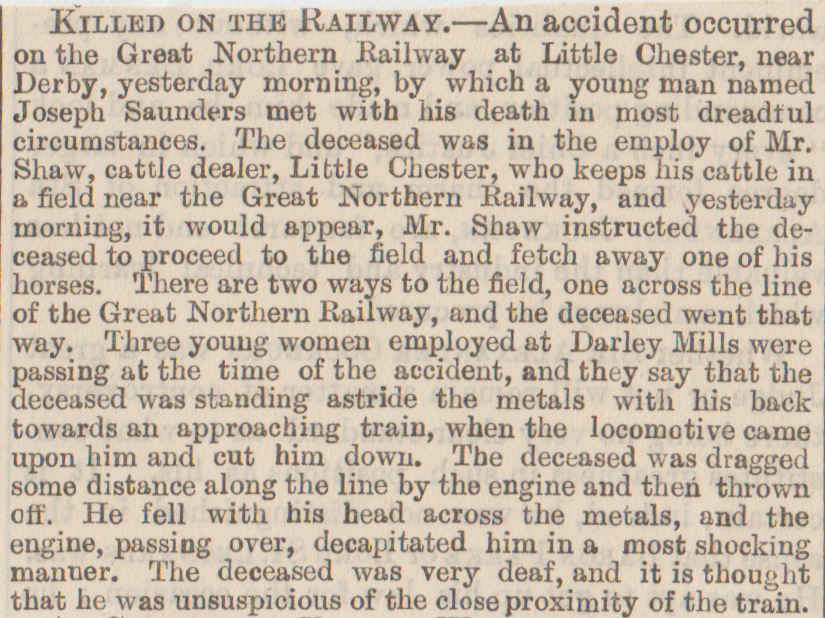
88/ Wife Murdered by Husband, Hadfield, near Glossop. October 4th, 1880
Tuesday, 9th November 1880.
At Glossop Police Court, yesterday, Albert Robertson, twenty-one, spinner, was committed for trial for the murder of his wife at Hadfield, on the 2nd of October, by cutting her throat. The prisoner afterwards attempted to commit suicide.
89/ Death at Midland Railway Station, Derby. December 1st, 1880
Wednesday, 2nd December 1880.
The inquest came to the conclusion that she had died from disease of the heart and that any sudden anxiety would be sufficient to bring on fatal symptoms. The verdicy of the jury was “that deceased died from heart disease accelerated by fright”

